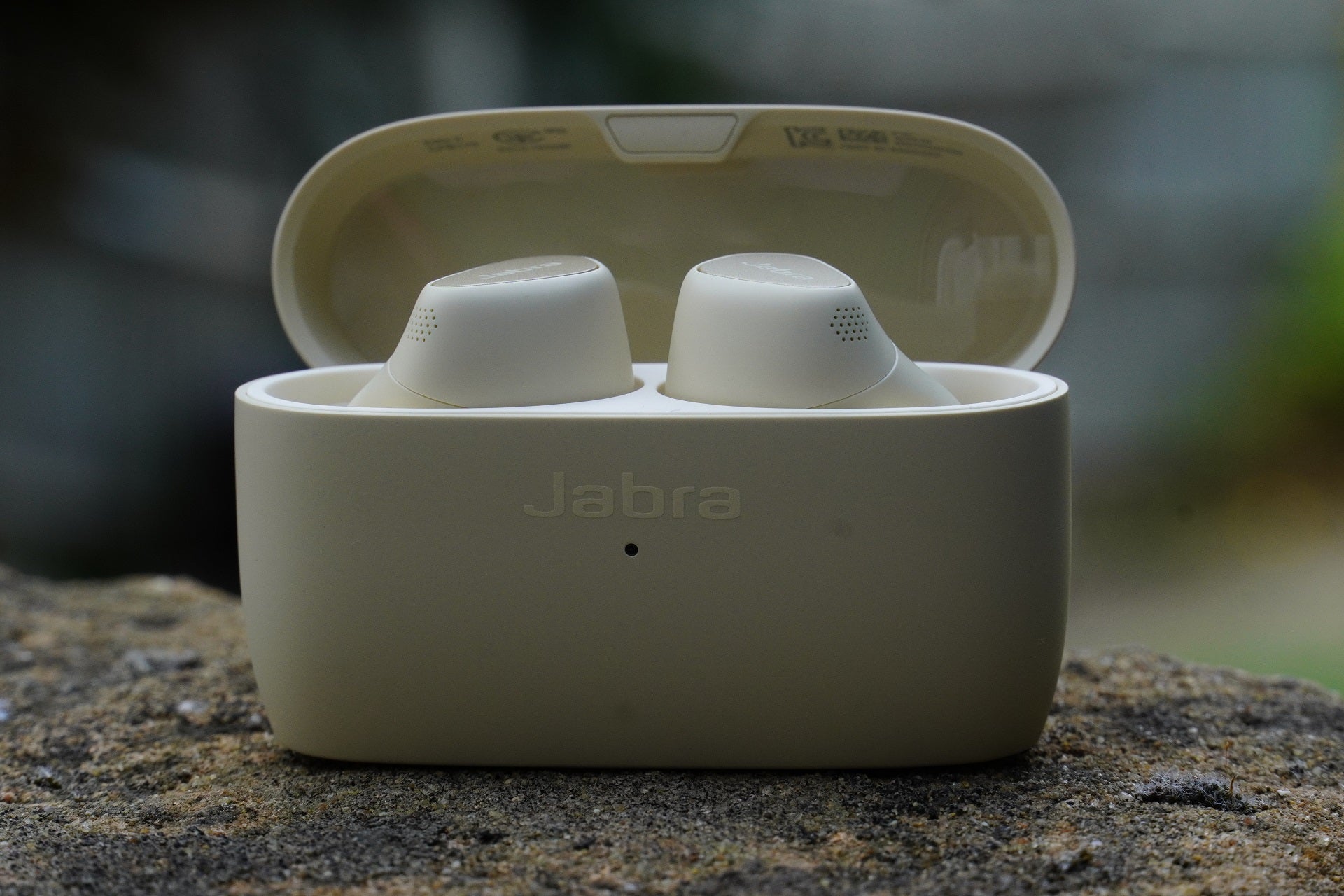Verdict
The Elite 5 are another fine and likable true wireless pair from Jabra, their audio quality is solid, their call performance is very good and the noise-cancelling experience takes away some of the stress out of everyday life.
Pros
- Good, comfortable fit
- Easy to use
- Effective noise-cancelling
- Rich, warm sound has appeal
Cons
- Lacks dynamism
- No onboard controls for volume
- Battery life a little less than claimed
Availability
- UKRRP: £149
- EuropeRRP: €149.99
- CanadaRRP: CA$199.99
- AustraliaRRP: AU$219
-
Hybrid ANCAdvanced noise-cancelling to block sounds -
6-mic call technologySix mic set-up for clearer call quality -
Spotify TapFast access to Spotify streaming
Introduction
Jabra’s Elite 5 are here to be your partner throughout the day, whether you’re ingesting the latest Tik Tok trends, listening to music or making calls, they’re positioned as a true wireless pair that move seamlessly from ‘work’ to ‘play’.
Sitting in the middle of the Jabra’s now extensive true wireless range, they’re a close sibling to the Elite 7 Pro and they best that model with their use of hybrid noise-cancelling technology.
Although the Elite 5 aren’t Jabra’s flagship true wireless – that title still belongs to the Elite 85t – they aim to bring a similar level of performance at a more affordable price, targeting the more youthful pocket of the headphone market.
If you’re a highly stressed individual – and aren’t we all these days? – Jabra’s Elite 5 aim to present a semblance of calm, but just how serene are these wireless earbuds?
Design
- Snug fit
- No onboard volume controls
- Strong water resistance
Jabra’s recent revamp of its true wireless earphones shares a design aesthetic that ensures a consistent but not identical appearance across several devices. Compare the Elite 7 Pro and Elite 5 for instance – both have an ergonomic shape that’s distinctively Jabra, but while the Elite 5 are slightly bigger in every dimension, they are lighter (5g to 5.4g).
They fit in the ear well, although the Elite 5 are probably the first Jabra true wireless I’ve reviewed where they didn’t instantaneously mould themselves to my ear. A little bit of jostling righted the earbuds’ placement, and from there on I found the usual snug levels of comfort.
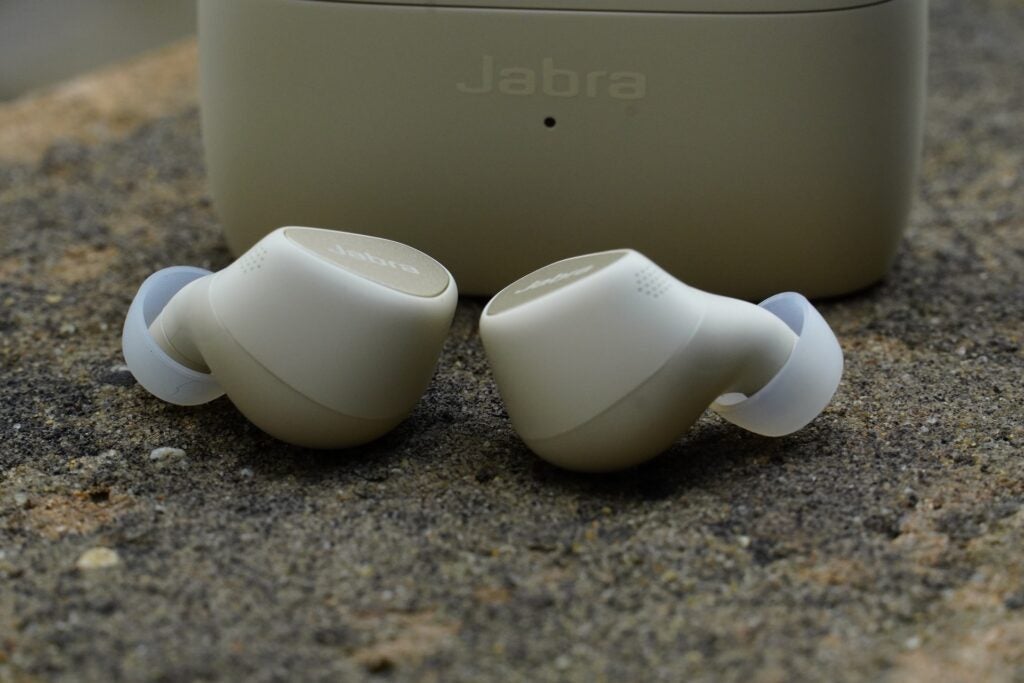
It’s business as usual in other areas too, with Jabra still relying on physical buttons for operation over touch controls. Pressing the button doesn’t require much force, nor does it alter the snug feel of the fit. Three sets of Jabra’s EarGel ear-tips are provided in small, medium and large sizes to suit different fits.
There’s no volume control onboard, nor is there the possibility of adding it through the app, which means liberating your mobile device from your pocket to change the volume.
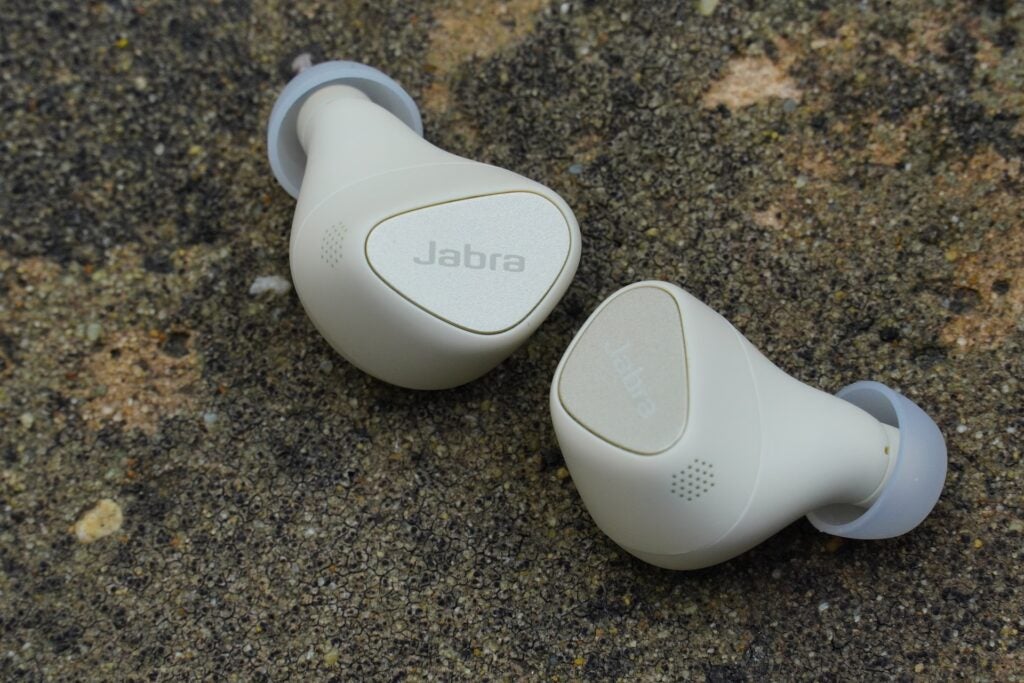
Otherwise, all the usual methods of operation are included such as play/pause, skipping tracks, accessing noise-cancelling modes and waking up your preferred voice assistant, with ANC/HearThrough modes accessible on the left earbud.
With an IP55 rating, the Elite 5 are protected against low levels of dust and low-pressure jets of water from any direction, so they should be able to cope with anything other than a whopper of a thunderstorm. There’s no mention of a similar IP rating for the charging case I should add.
The charging case differs in its dimensions from the Elite 7 Pro in that it is taller but slimmer, but I don’t think that makes a difference in terms of slipping it in a pocket. Colours include Black, Titanium Black and a fetching Gold Beige.
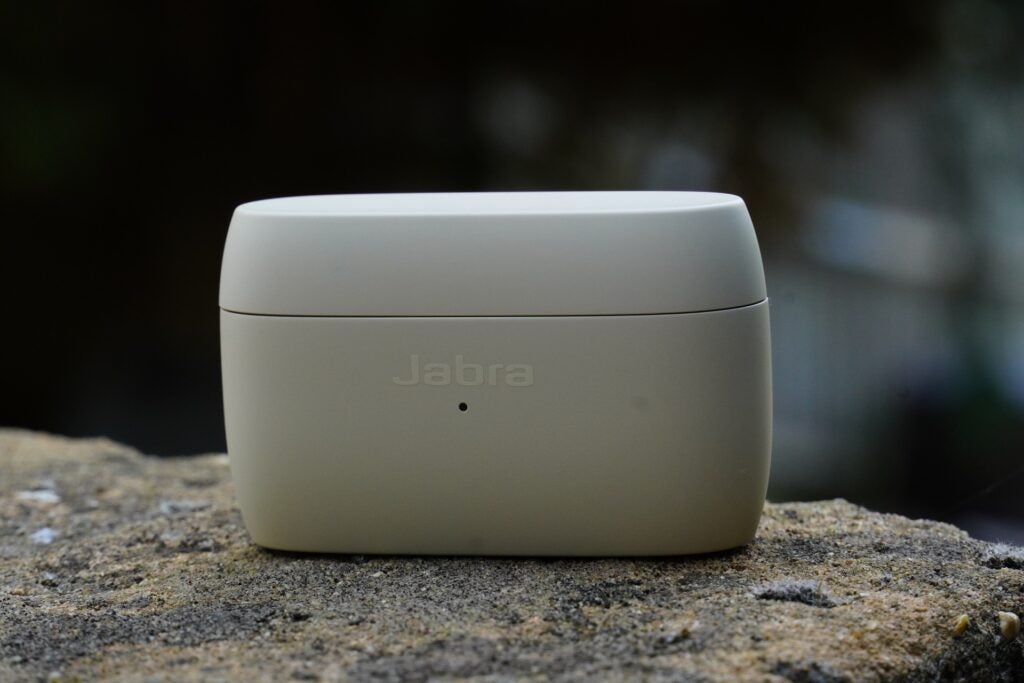
Features
- Effective noise-cancelling
- Battery life less than quoted
- Very good call quality performance
Customisation is at the forefront of Jabra’s Sound+ app. The strength of the active noise-cancellation can be tailored to shut out as much noise as you want. The music equalizer offers six presets (Neutral, Speech, Treble boost, Bass Boost, Smooth and Energize), although there’s no means of crafting your own.
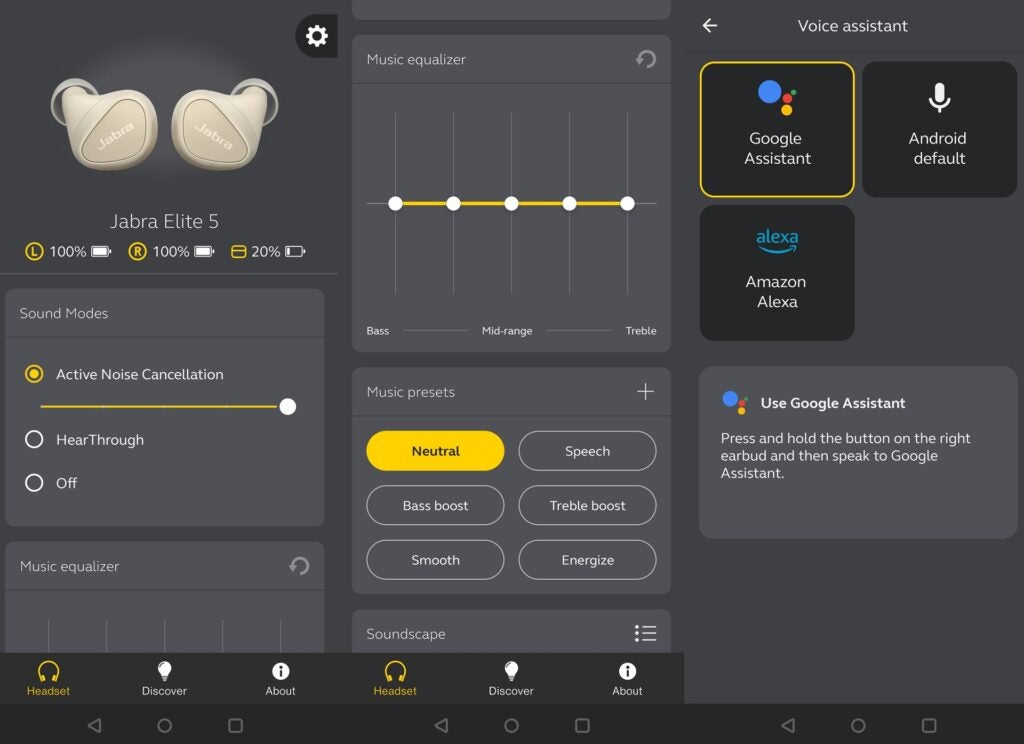
Sound Modes swaps through the noise-canceling modes (ANC, HearThrough and Off), with ANC and Transparency modes adjustable through a slider. Soundscapes presents a range of noises that simulate real-world sounds (a waterfall, ocean waves, a literal babbling brook) for those moments when you want to chill out. You can also edit the order of the widgets or whether you want to see them at all.
Move to the cog icon in the top right-hand corner and there are more settings to play with such as updating the firmware, enabling Spotify Tap (which directs you to the app via a double press on the left bud), voice assistance (a choice of your device’s native assistant: Google or Alexa, both of which are built-in), control customisation (the left bud is rather bare, which makes the omission of volume control odder still), and personalized ANC, where the overall strength and balance between right and left buds can be altered.

Jabra has made it clear that the Elite 85t are still the flagship bearer for noise-cancellation, so the Elite 5 aren’t intended to replace them. They do bear hybrid noise-cancellation, a more advanced version of the technology that uses microphones to block external sounds (noises coming at you) and internal sounds (within the in-ear area) to suppress noise.
The performance is satisfying. Again, these aren’t intended to be comprehensive – not in the same sense as the Sony WF-1000XM4 or Bose QuietComfort Earbuds – but they did dampen most noises I encountered.
Whether it’s the sound of traffic or people moving past: the rumble of an idling motorcycle engine, people on buses, the noise of the London Underground or buffing out persistent noises like air conditioning or my laptop’s irritating fan system; it’s effective enough to de-stress any environment you find yourself in.
I found the HearThrough (transparency) mode better than the Elite 7 Pro. It’s clearer and more natural in tone and doesn’t try to amplify sounds. It offers good situational awareness too, as I could clearly sense people and things around me.
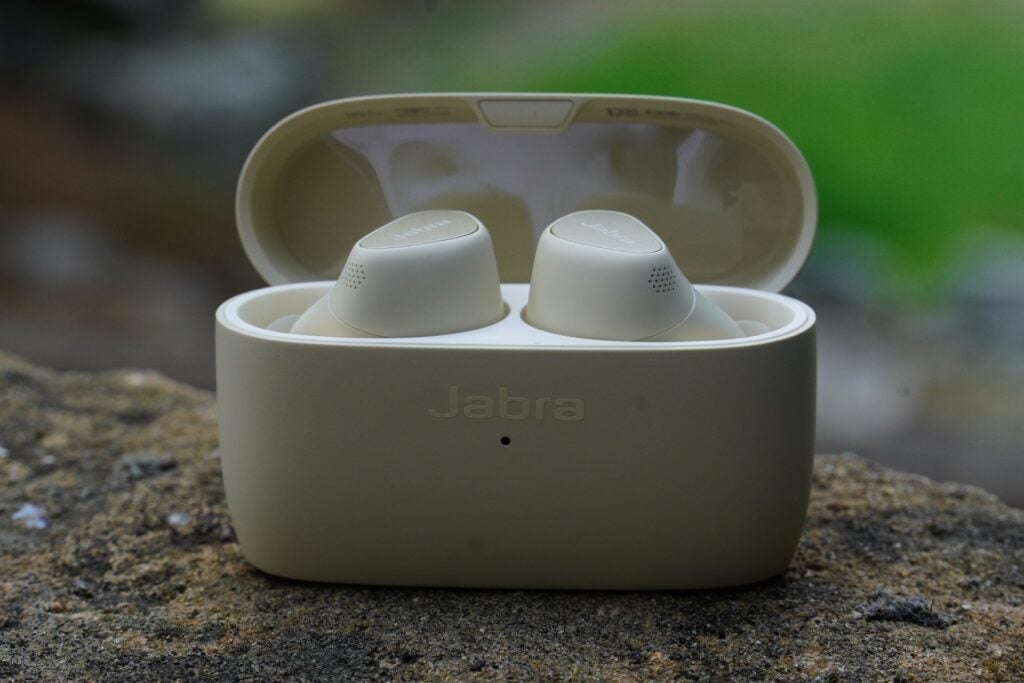
The Elite 5 support Bluetooth 5.2 with room for audio codecs such as SBC, AAC and Qualcomm’s aptX. The buds aren’t a fan of crowded places though, as a stuttering signal was regularly encountered in places such as train stations.
Jabra has always been one of the better brands for good call quality and that continues with the Elite 5. While the person on the other end of call did mention a rustling sound that neither one of us could figure out, surrounding noises were handled well and the sounds that did penetrate (like an ambulance siren) didn’t distract.
The Elite 5 offer a good balance at maintaining vocal clarity without being too heavy on the noise cancelling unlike the LG UT90Q. It’s another confident call performance from Jabra, especially for a true wireless.
Battery life is quoted at up to seven hours with ANC on (nine with it off), and up to 28-hours of ANC with the case (36-hours without ANC), with Jabra quoting these figures from tests done at AAC/aptX. Are those figures borne out by use? I’d say it probably depends on volume and perhaps even noise-cancelling strength.
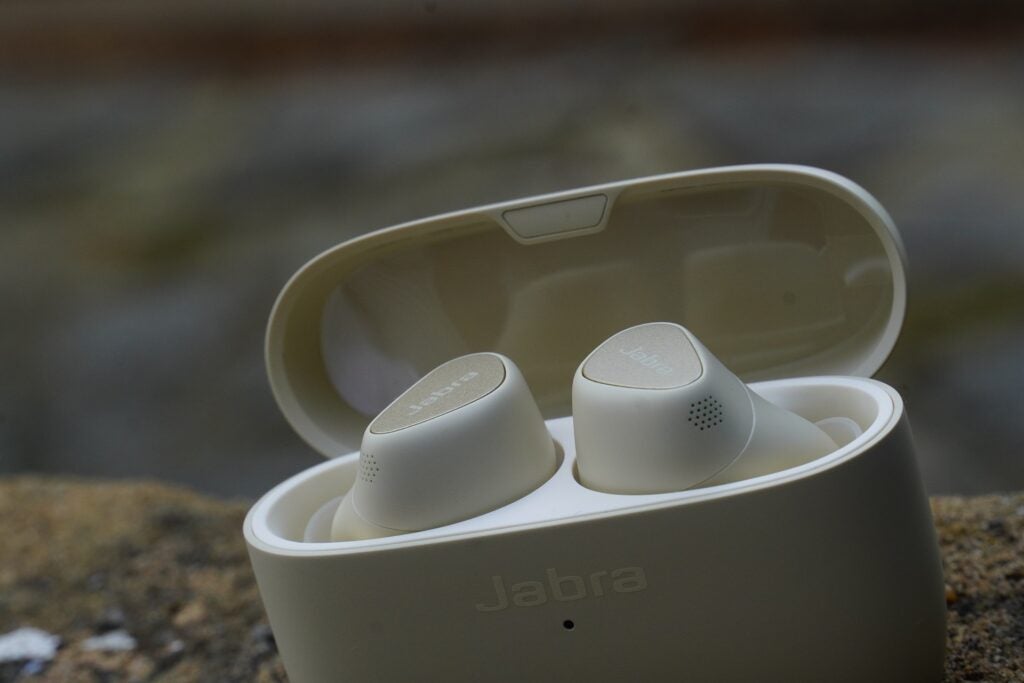
With the volume a few ticks north of its default level, the Sound+ app registered 75% battery left in the tank (for both left and right), while the Android UI had the figure at 80% after an hour’s streaming of Tidal. The Jabra seems to be in the four-to-five-hour mark
Other features include wear sensor tech, fast and wireless charging, Google Fast Pair, Microsoft Swift Pair (both for connecting quickly to compatible devices) and Made for iPhone (MFi) certification, which means it’s been verified for use with Apple products.
Sound Quality
- Rich presentation
- Lacks dynamism
- Elite 85t still a better-sounding option
Jabra’s Elite range has mixed things up in terms of how rich or neutral they sound, and like the Elite 3, the Elite 5 find themselves at the richer end of the audio spectrum.
A listen to Jacob Collier’s All I Need brings out more warmth and richness to voices and guitars on the Elite 5 compared to the Elite 7 Pro. The Elite 7 Pro approaches low frequencies with a little more clarity and punch, especially at higher volumes, whereas the Elite 5’s richer character presents them with more depth and presence.
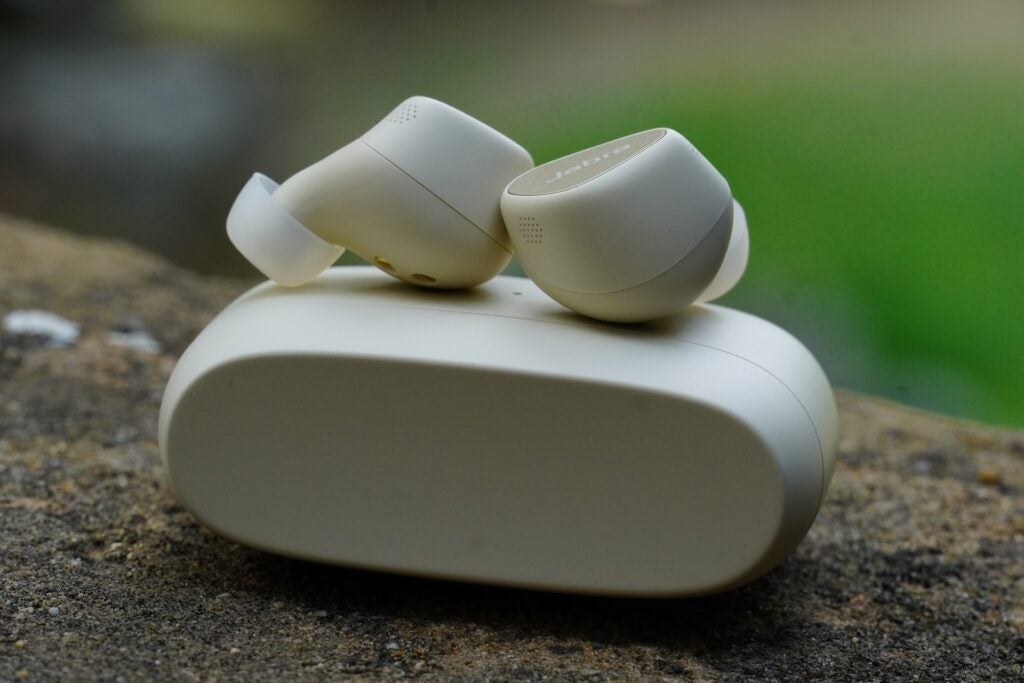
Aside from the warmth, there’s little to distinguish between them overall, which neatly sums up their differences. After a clearer, neutral presentation? Go for the Elite 7 Pro. If you favour a richer sound and an emphasis on bass, take a look at the Elite 5 instead.
When dealing with high frequencies, the Elite 5’s warmth doesn’t draw out the same level of crispness or detail to the cymbal crashes in By.Alexander and 070 Shake’s Trumpets, nor is there the same level of clarity given to 070 Shake’s vocals. But arguably that’s trumpeted (pun intended) by the Elite 5’s warmth, granting more weight to voices where they feel a little more brittle on the Elite 7 Pro.
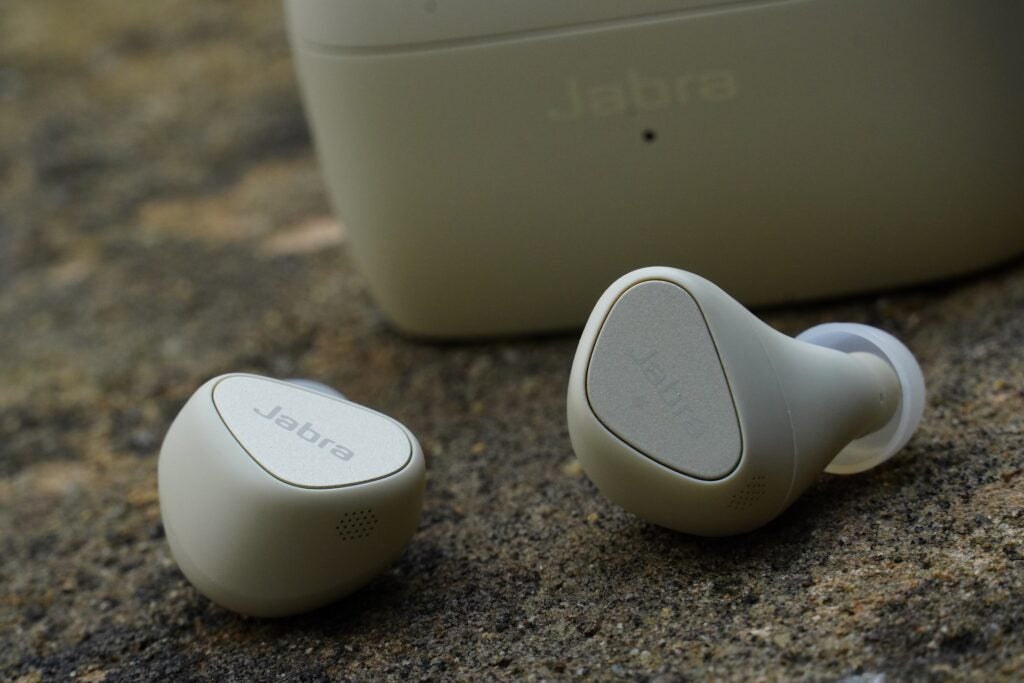
I found the way the default Neutral EQ describes the soundstage a little humdrum for my tastes – my preference was to go for the V-shaped Energize preset. This does lead to the midrange (and vocals) being recessed as treble and bass frequencies are amplified, but, I’d say that given the richness of the presentation, it can work better than the Neutral preset does with music genres such as hip-hop and jazz.
However, Neutral does place vocals on a more even keel, although with some tracks you won’t notice much of a difference other than the Neutral offering a slightly wider soundstage.
Like the Elite 7 Pro, the Elite 5’s sense of dynamism is one where everything is pitched at the same level. Differences between quiet and loud aren’t so much peaks and troughs but a straight line with mild bumps. Listening to Galadriel from the Rings of Power soundtrack, the Elite 5 couldn’t capture the swells of the orchestra as well as the Elite 85t.
Scale and energy only make an appearance with the volume pushed up, so despite the richness, the Elite 5 remain a little reserved, as if they don’t want to usher the Elite 85t off the stage, which still remain as Jabra’s best-sounding true wireless.
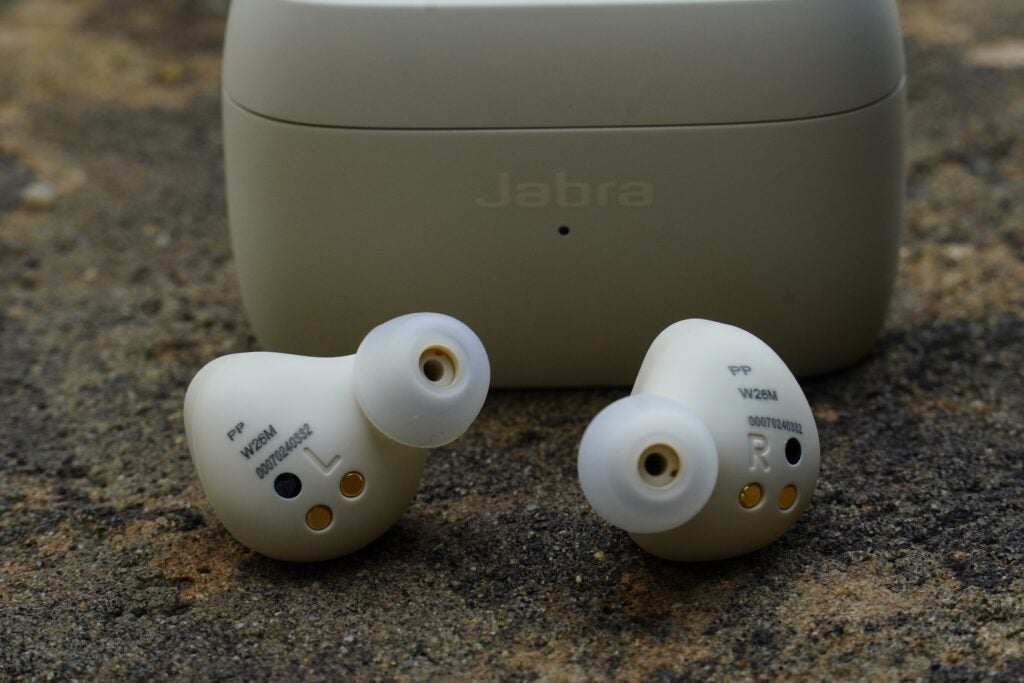
Latest deals
Should you buy it?
If you appreciate Jabra’s lightweight touch with design: Once the buds settle in, Elite 5 prove to be another comfortable pair to wear from Jabra
If you want a more expressive sound: Though the Elite 5 have more personality thanks to their rich sound compared to the Elite 7 Pro, they still lack dynamism
Final Thoughts
If there’s a theme to this review, it’s that the Elite 5 is business as usual for Jabra. The design and fit are as reliable as ever, the noise cancellation effective, and call quality is very good.
Their richer tone boast more of a personality than the Elite 7 Pro but in terms of warmth and richness you’ll find similarly priced models such as the Sony LinkBuds S featuring more clarity, dynamism and verve. Nevertheless, the Elite 5 are another solid, versatile true wireless pair from Jabra, and if you need some earbuds with solid call quality then there aren’t many better than the Elite 5 at this price.
How we test
We test every set of headphones we review thoroughly over an extended period of time. We use industry standard tests to compare features properly. We’ll always tell you what we find. We never, ever, accept money to review a product.
Find out more about how we test in our ethics policy.
Tested with real world use
FAQs
The main differences are that the Elite 5 true wireless are slightly cheaper than the Elite 7 Pro, and feature more advanced hybrid noise-cancelling technology.
Jargon buster
ANC
ANC (Active Noise Cancellation) uses an array of microphones in a headphone to detect the frequency of the sound coming at the listener, with the ANC chip creating an inverse wave (i.e. opposing sound) to suppress any unwanted external noises.
IP rating
An abbreviation for ‘Ingress Protection Code’, which lets you know to what extent a device might be waterproof or dustproof.
Verdict
The Elite 5 are another fine and likable true wireless pair from Jabra, their audio quality is solid, their call performance is very good and the noise-cancelling experience takes away some of the stress out of everyday life.
Pros
- Good, comfortable fit
- Easy to use
- Effective noise-cancelling
- Rich, warm sound has appeal
Cons
- Lacks dynamism
- No onboard controls for volume
- Battery life a little less than claimed
Availability
- UKRRP: £149
- EuropeRRP: €149.99
- CanadaRRP: CA$199.99
- AustraliaRRP: AU$219
-
Hybrid ANCAdvanced noise-cancelling to block sounds -
6-mic call technologySix mic set-up for clearer call quality -
Spotify TapFast access to Spotify streaming
Introduction
Jabra’s Elite 5 are here to be your partner throughout the day, whether you’re ingesting the latest Tik Tok trends, listening to music or making calls, they’re positioned as a true wireless pair that move seamlessly from ‘work’ to ‘play’.
Sitting in the middle of the Jabra’s now extensive true wireless range, they’re a close sibling to the Elite 7 Pro and they best that model with their use of hybrid noise-cancelling technology.
Although the Elite 5 aren’t Jabra’s flagship true wireless – that title still belongs to the Elite 85t – they aim to bring a similar level of performance at a more affordable price, targeting the more youthful pocket of the headphone market.
If you’re a highly stressed individual – and aren’t we all these days? – Jabra’s Elite 5 aim to present a semblance of calm, but just how serene are these wireless earbuds?
Design
- Snug fit
- No onboard volume controls
- Strong water resistance
Jabra’s recent revamp of its true wireless earphones shares a design aesthetic that ensures a consistent but not identical appearance across several devices. Compare the Elite 7 Pro and Elite 5 for instance – both have an ergonomic shape that’s distinctively Jabra, but while the Elite 5 are slightly bigger in every dimension, they are lighter (5g to 5.4g).
They fit in the ear well, although the Elite 5 are probably the first Jabra true wireless I’ve reviewed where they didn’t instantaneously mould themselves to my ear. A little bit of jostling righted the earbuds’ placement, and from there on I found the usual snug levels of comfort.

It’s business as usual in other areas too, with Jabra still relying on physical buttons for operation over touch controls. Pressing the button doesn’t require much force, nor does it alter the snug feel of the fit. Three sets of Jabra’s EarGel ear-tips are provided in small, medium and large sizes to suit different fits.
There’s no volume control onboard, nor is there the possibility of adding it through the app, which means liberating your mobile device from your pocket to change the volume.

Otherwise, all the usual methods of operation are included such as play/pause, skipping tracks, accessing noise-cancelling modes and waking up your preferred voice assistant, with ANC/HearThrough modes accessible on the left earbud.
With an IP55 rating, the Elite 5 are protected against low levels of dust and low-pressure jets of water from any direction, so they should be able to cope with anything other than a whopper of a thunderstorm. There’s no mention of a similar IP rating for the charging case I should add.
The charging case differs in its dimensions from the Elite 7 Pro in that it is taller but slimmer, but I don’t think that makes a difference in terms of slipping it in a pocket. Colours include Black, Titanium Black and a fetching Gold Beige.

Features
- Effective noise-cancelling
- Battery life less than quoted
- Very good call quality performance
Customisation is at the forefront of Jabra’s Sound+ app. The strength of the active noise-cancellation can be tailored to shut out as much noise as you want. The music equalizer offers six presets (Neutral, Speech, Treble boost, Bass Boost, Smooth and Energize), although there’s no means of crafting your own.

Sound Modes swaps through the noise-canceling modes (ANC, HearThrough and Off), with ANC and Transparency modes adjustable through a slider. Soundscapes presents a range of noises that simulate real-world sounds (a waterfall, ocean waves, a literal babbling brook) for those moments when you want to chill out. You can also edit the order of the widgets or whether you want to see them at all.
Move to the cog icon in the top right-hand corner and there are more settings to play with such as updating the firmware, enabling Spotify Tap (which directs you to the app via a double press on the left bud), voice assistance (a choice of your device’s native assistant: Google or Alexa, both of which are built-in), control customisation (the left bud is rather bare, which makes the omission of volume control odder still), and personalized ANC, where the overall strength and balance between right and left buds can be altered.

Jabra has made it clear that the Elite 85t are still the flagship bearer for noise-cancellation, so the Elite 5 aren’t intended to replace them. They do bear hybrid noise-cancellation, a more advanced version of the technology that uses microphones to block external sounds (noises coming at you) and internal sounds (within the in-ear area) to suppress noise.
The performance is satisfying. Again, these aren’t intended to be comprehensive – not in the same sense as the Sony WF-1000XM4 or Bose QuietComfort Earbuds – but they did dampen most noises I encountered.
Whether it’s the sound of traffic or people moving past: the rumble of an idling motorcycle engine, people on buses, the noise of the London Underground or buffing out persistent noises like air conditioning or my laptop’s irritating fan system; it’s effective enough to de-stress any environment you find yourself in.
I found the HearThrough (transparency) mode better than the Elite 7 Pro. It’s clearer and more natural in tone and doesn’t try to amplify sounds. It offers good situational awareness too, as I could clearly sense people and things around me.

The Elite 5 support Bluetooth 5.2 with room for audio codecs such as SBC, AAC and Qualcomm’s aptX. The buds aren’t a fan of crowded places though, as a stuttering signal was regularly encountered in places such as train stations.
Jabra has always been one of the better brands for good call quality and that continues with the Elite 5. While the person on the other end of call did mention a rustling sound that neither one of us could figure out, surrounding noises were handled well and the sounds that did penetrate (like an ambulance siren) didn’t distract.
The Elite 5 offer a good balance at maintaining vocal clarity without being too heavy on the noise cancelling unlike the LG UT90Q. It’s another confident call performance from Jabra, especially for a true wireless.
Battery life is quoted at up to seven hours with ANC on (nine with it off), and up to 28-hours of ANC with the case (36-hours without ANC), with Jabra quoting these figures from tests done at AAC/aptX. Are those figures borne out by use? I’d say it probably depends on volume and perhaps even noise-cancelling strength.

With the volume a few ticks north of its default level, the Sound+ app registered 75% battery left in the tank (for both left and right), while the Android UI had the figure at 80% after an hour’s streaming of Tidal. The Jabra seems to be in the four-to-five-hour mark
Other features include wear sensor tech, fast and wireless charging, Google Fast Pair, Microsoft Swift Pair (both for connecting quickly to compatible devices) and Made for iPhone (MFi) certification, which means it’s been verified for use with Apple products.
Sound Quality
- Rich presentation
- Lacks dynamism
- Elite 85t still a better-sounding option
Jabra’s Elite range has mixed things up in terms of how rich or neutral they sound, and like the Elite 3, the Elite 5 find themselves at the richer end of the audio spectrum.
A listen to Jacob Collier’s All I Need brings out more warmth and richness to voices and guitars on the Elite 5 compared to the Elite 7 Pro. The Elite 7 Pro approaches low frequencies with a little more clarity and punch, especially at higher volumes, whereas the Elite 5’s richer character presents them with more depth and presence.

Aside from the warmth, there’s little to distinguish between them overall, which neatly sums up their differences. After a clearer, neutral presentation? Go for the Elite 7 Pro. If you favour a richer sound and an emphasis on bass, take a look at the Elite 5 instead.
When dealing with high frequencies, the Elite 5’s warmth doesn’t draw out the same level of crispness or detail to the cymbal crashes in By.Alexander and 070 Shake’s Trumpets, nor is there the same level of clarity given to 070 Shake’s vocals. But arguably that’s trumpeted (pun intended) by the Elite 5’s warmth, granting more weight to voices where they feel a little more brittle on the Elite 7 Pro.

I found the way the default Neutral EQ describes the soundstage a little humdrum for my tastes – my preference was to go for the V-shaped Energize preset. This does lead to the midrange (and vocals) being recessed as treble and bass frequencies are amplified, but, I’d say that given the richness of the presentation, it can work better than the Neutral preset does with music genres such as hip-hop and jazz.
However, Neutral does place vocals on a more even keel, although with some tracks you won’t notice much of a difference other than the Neutral offering a slightly wider soundstage.
Like the Elite 7 Pro, the Elite 5’s sense of dynamism is one where everything is pitched at the same level. Differences between quiet and loud aren’t so much peaks and troughs but a straight line with mild bumps. Listening to Galadriel from the Rings of Power soundtrack, the Elite 5 couldn’t capture the swells of the orchestra as well as the Elite 85t.
Scale and energy only make an appearance with the volume pushed up, so despite the richness, the Elite 5 remain a little reserved, as if they don’t want to usher the Elite 85t off the stage, which still remain as Jabra’s best-sounding true wireless.

Latest deals
Should you buy it?
If you appreciate Jabra’s lightweight touch with design: Once the buds settle in, Elite 5 prove to be another comfortable pair to wear from Jabra
If you want a more expressive sound: Though the Elite 5 have more personality thanks to their rich sound compared to the Elite 7 Pro, they still lack dynamism
Final Thoughts
If there’s a theme to this review, it’s that the Elite 5 is business as usual for Jabra. The design and fit are as reliable as ever, the noise cancellation effective, and call quality is very good.
Their richer tone boast more of a personality than the Elite 7 Pro but in terms of warmth and richness you’ll find similarly priced models such as the Sony LinkBuds S featuring more clarity, dynamism and verve. Nevertheless, the Elite 5 are another solid, versatile true wireless pair from Jabra, and if you need some earbuds with solid call quality then there aren’t many better than the Elite 5 at this price.
How we test
We test every set of headphones we review thoroughly over an extended period of time. We use industry standard tests to compare features properly. We’ll always tell you what we find. We never, ever, accept money to review a product.
Find out more about how we test in our ethics policy.
Tested with real world use
FAQs
The main differences are that the Elite 5 true wireless are slightly cheaper than the Elite 7 Pro, and feature more advanced hybrid noise-cancelling technology.
Jargon buster
ANC
ANC (Active Noise Cancellation) uses an array of microphones in a headphone to detect the frequency of the sound coming at the listener, with the ANC chip creating an inverse wave (i.e. opposing sound) to suppress any unwanted external noises.
IP rating
An abbreviation for ‘Ingress Protection Code’, which lets you know to what extent a device might be waterproof or dustproof.


















